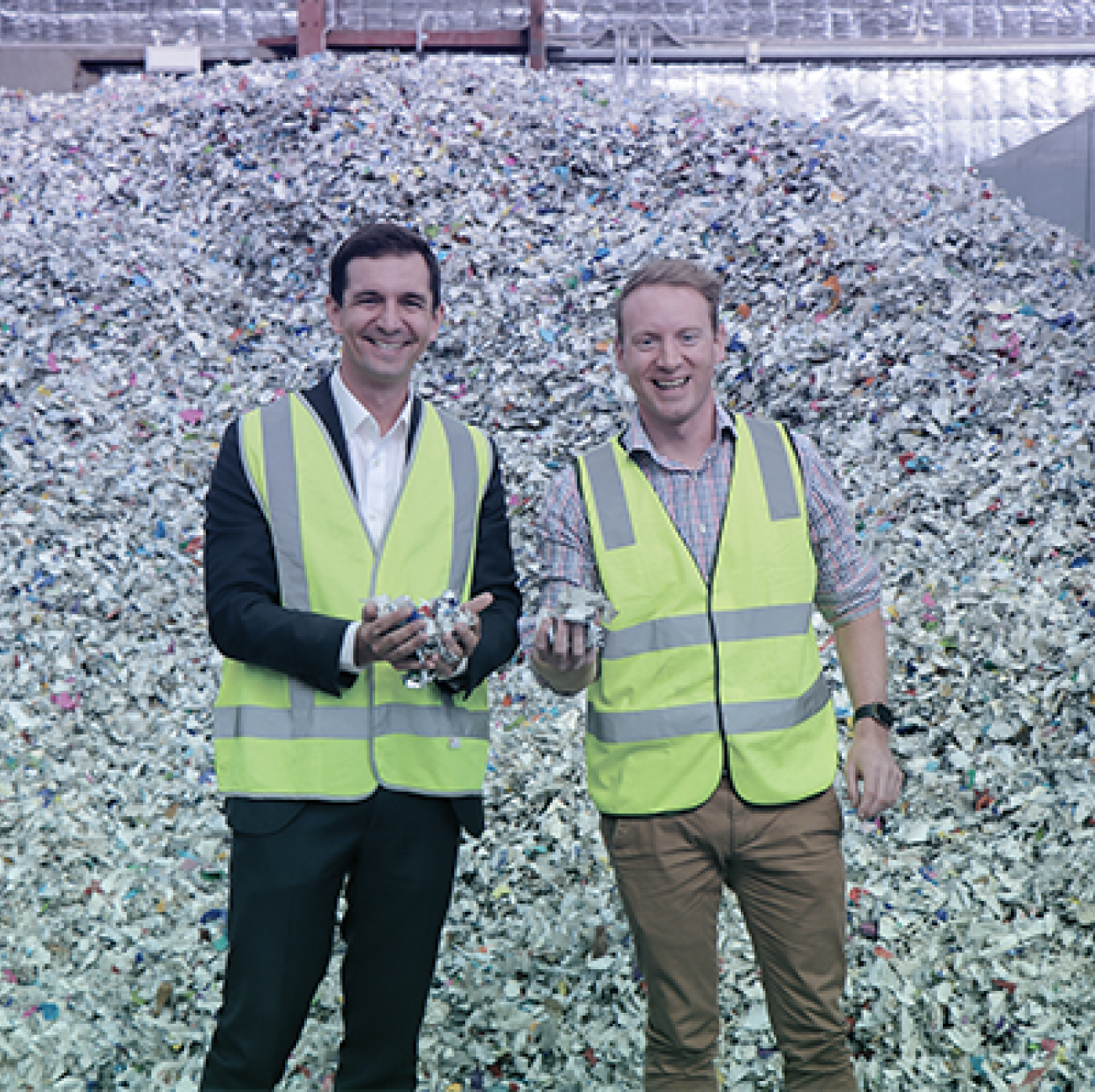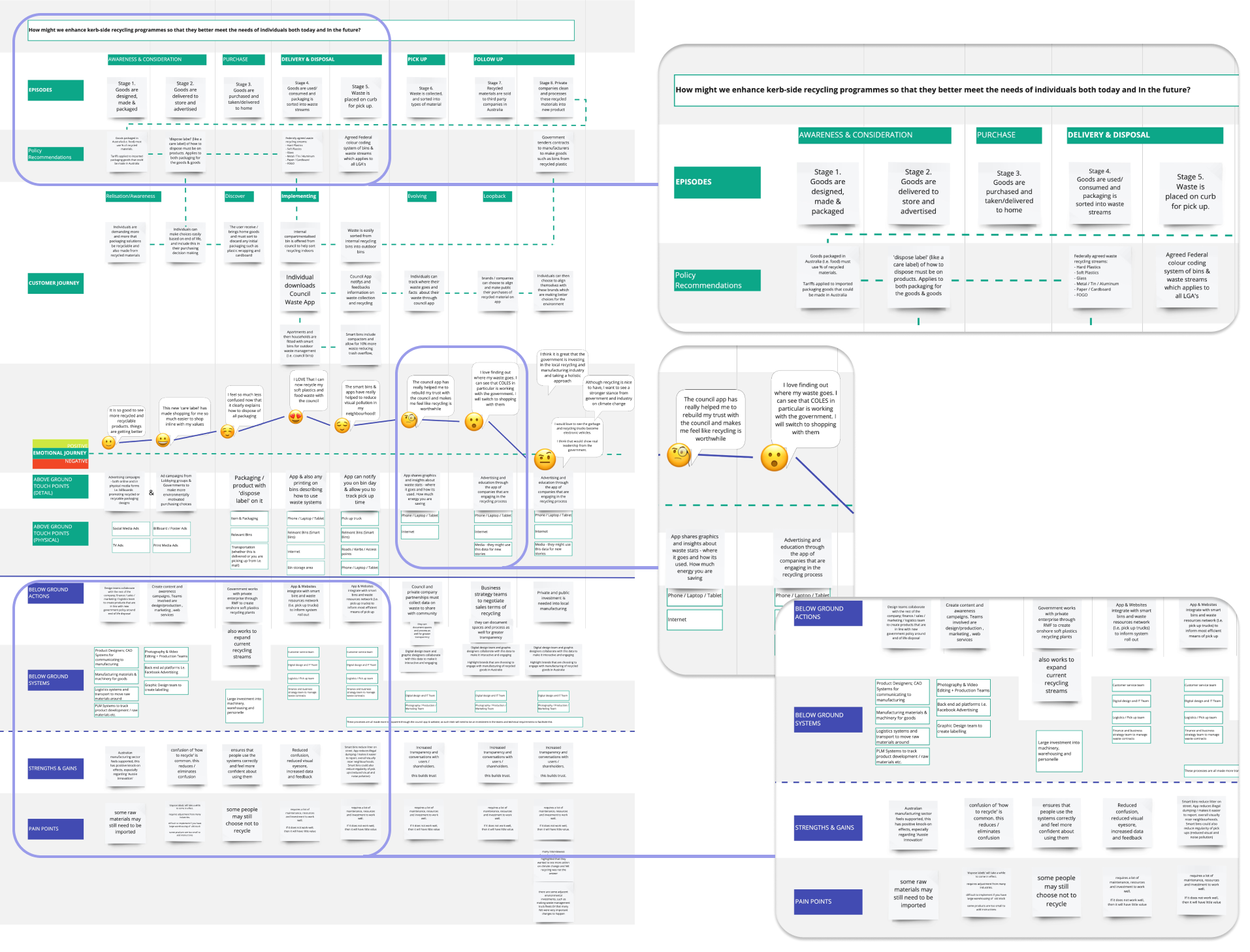ReImagining Recycling
Solo Student Project
Academy Xi - Service Design Certificate
June - September 2021 (12 Weeks)
Problem
Context
Prior to 2021 Australia exported 4.5million tonnes of waste overseas. These export markets are now closed due to new import standards introduced in China and South East Asia.
When the full export ban comes into effect Australia must recycle around 645,000 tonnes of additional waste each year.
Response
The government has established the Recycling Modernisation Fund with an initial investment of $190 million dollars.
The funds are yet to be allocated.
Challenge
This project investigates the ways in which the fund could drive innovation whilst solving this complex problem at speed.
It places the everyday citizen at the heart of the experience to ensure long-term sustainability.
Solution
Clarify
Currently, users are confused about how to categorise their waste, this can be solved through a combination of policy and physical and digital solutions.
Codify
Part of this confusion is driven by the fact that each LGA negotiates their own contracts and process. An adaptable national framework needs to be implemented to create better outcomes for citizens, businesses, and government.
Circularity
Machinery within industry needs to be improved to reflect international standards and technological developments. This will enable circular economy opportunities within Australia.
How might we transform recycling into a more engaging and enjoyable experience so that individuals build life-long habits of recycling?
Reverse Brief Process
What?
Increase engagement
Reduce land-fill waste and environmental pollution
Form & encourage habits
Reduce pain-points to citizens
Why?
It is critical that infrastructure transformations meet the needs of individuals to ensure maximum uptake
How?
Quantitative research leveraging high-quality studies from the CSIRO
Connecting with a wide range of citizens through interviews
Contextual Enquiry: Observing how citizens engage with their current systems
Who?
Broad population, solutions need to be accessible to all citizens.
Craft outcomes for both urban and rural populations.
Various ways of living; apartments, sharehouses, homes.
When?
Short-Term Deliverables: Current and future service state blueprint
Long-Term Goals: Establish roadmaps to implement blueprint outcomes
Roadblocks?
The sector is very fragmented and is divided by capabilities related to materials and technologies.
Gaining access to information to map back-end processes could be time-consuming and difficult
Interviews
A series of in-depth interviews were conducted, with a diverse set of users.
These are some of the key quotes that begin to represent some of the main pain points within the current experience.
"Covid has caused a massive shift in my habits - I shop way more than I usually do just because of pure boredom. I need something to be excited for"
Grace | 22 | Share House
"Other places just have two bins, it really is just an outrageous waste to have 4 separate bins, It’s just ugly - you have the bin lids screaming at you"
Jerry | 82 | Suburban House
"I definitely feel like the rules around what can and can’t be recycled are somewhat different depending what suburb you are in. It is quite confusing"
Stephanie | 30 | Urban Apartment
"We chose smaller bins, to try and prompt us to generate less waste, but also because we built a bin cupboard so we didn’t have to look at them all the time"
Mike | 49 | Urban House
Synthesis
Affinity Map
Empathy Map
Key Findings for Users
The Solution Needs To:
Bring greater transparency to the back-end process
Be easy and convenient to access
Create a sense of community
Be aesthetically pleasing
This reduces pain points by:
Building trust in the system
Reducing visual pollution
Clarifying purpose
And adds value by:
Off-setting consumption guilt
Delivering practical solutions for everyday problems
Persona
Customer Journey Map
Key Findings | Stakeholders
The Opportunities Are:
Reduction of infrastructure damaging ‘wish-cycling’
Creating resources from waste
Future-proofing a critical industry that is currently lagging.
Ideating
How Might We?
This was an insightful process as it demonstrates how the core HMW evolves now that there is more insight into the problem from the research phase. The new HMW is more specific to the context and users:
How might we enhance kerb-side recycling programmes so that they better meet the needs of individuals both today and in the future?
Crazy 8’s
This is just one example of a few scenarios that were explored with this methodology. It revealed that many of the solutions are legislative and spatial ones.
Concept Cards
The most viable ideas from the crazy 8’s exercise were then explored in more detail through this format.
Storyboarding
Lastly, this was a quick and easy way to test concepts in relation to a real-world scenario. I generated many storyboards, this is an example of one which includes a microwave meal that has multiple components that need to be sorted into waste streams.
It confirmed the complexity of this issue in a daily-use situation and highlighted that digital solutions will be less useful here.
Evaluating Solutions
One
Mapping the research and ideas together revealed that the solution will need to be multifaceted combining different technologies and resources, as well as collaborating between private and public sector stakeholders to create a positive change in the customer experience.
Two
Once I was satisfied with the level of ideating, I used a value matrix and lo-fi service flow to clarify what the future service flow might look like.
Three
This was then translated into a roadmap to assess skills and technology needs against time.
Future Service Blueprint
The final blueprint combined solutions that were identified in the ideation phase as the issue was complex it needs transformation in multiple areas of the citizen journey.
A successful outcome will rely on the ability to leverage policy with government and private industry collaboration.
Lessons + Learnings
-
Rather than looking at it on a national level, like the Recycling Modernisation Fund does, it would be better to look at it from a state and then district level to better address gaps in lifestyle and focus on creating synergies within a particular area, as the service is intrinsically linked to geography and demographics of the area.
-
It’s easy to want to jump to a solution like ‘create an app’ to help build community & clarify information however what is abundantly clear through this research and design process, is that the foundations within the system are not there to warrant an app at this stage. That is why current apps and technology solutions have not been successful.
-
As the research process evolved so did the problem that needed to be solved…
It went from “How might we transform recycling into a more engaging and enjoyable experience so that individuals build life-long habits of recycling
and evolved into “How might we enhance kerb-side recycling programmes so that they better meet the needs of individuals both today and in the future?”
The problem became more specific and grounded within the landscape of the waste industry, whilst broadening the scope of possible outcomes.
Check out my other projects:


























